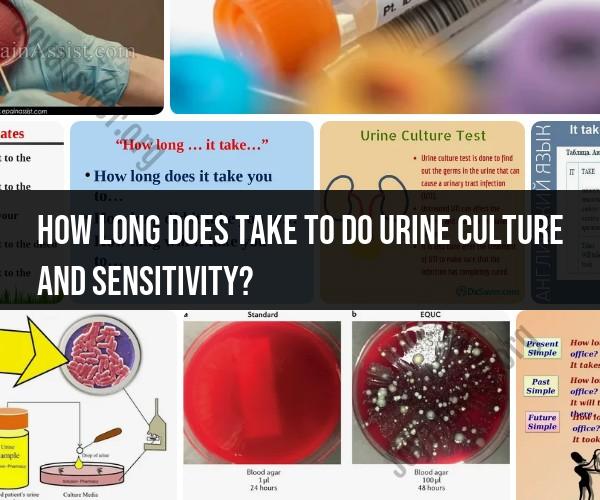How long does take to do urine culture and sensitivity?
The duration for conducting a urine culture and sensitivity test typically depends on several factors, including the laboratory's processing times, the type of culture method used, and the specific testing requirements. In general, you can expect the following timeframes for different phases of the urine culture and sensitivity process:
Sample Collection: Collecting a urine sample usually takes only a few minutes, as it involves providing a clean-catch or midstream urine specimen. The collection process itself is relatively quick and straightforward.
Transport to the Lab: After the sample is collected, it should be transported to the laboratory as soon as possible, ideally within a few hours to maintain sample integrity.
Inoculation and Incubation (Culture): Once the urine sample reaches the laboratory, it is inoculated onto culture plates or into a culture medium that promotes the growth of bacteria. The plates or cultures are then incubated at a specific temperature (usually 37°C or 98.6°F). This incubation period typically lasts 24 to 48 hours.
Initial Results: After the initial incubation period, the laboratory will check for the presence of bacterial growth in the culture. Preliminary results, which indicate whether bacteria are present, can often be available within 24 to 48 hours of sample receipt.
Identification and Sensitivity Testing: If bacterial growth is detected, further testing is performed to identify the specific type of bacteria (species) and determine which antibiotics are effective against it (sensitivity testing). This phase can take an additional 24 to 72 hours or longer, depending on the complexity of the analysis and the specific methods used by the laboratory.
Final Reporting: Once the identification and sensitivity testing are complete, the laboratory will provide a final report to the healthcare provider who ordered the test. This report typically includes information on the type of bacteria present, as well as a list of antibiotics and their effectiveness against the identified bacteria.
In summary, the total time for a urine culture and sensitivity test can range from approximately 2 to 5 days or more, depending on various factors. It's important to note that while preliminary results indicating bacterial growth may be available within the first 48 hours, the full identification of the bacteria and sensitivity testing may take additional time to ensure accurate and comprehensive results. The exact timeframe can vary between different laboratories and healthcare facilities. Patients should follow up with their healthcare providers to discuss the results once they are available.
Urine culture and sensitivity testing (UC&S) is a laboratory test that is used to identify bacteria or other microorganisms in the urine. The test also determines which antibiotics are effective in killing the bacteria or microorganisms that are found.
UC&S tests are typically ordered by doctors when they suspect a patient may have a urinary tract infection (UTI). UTIs are infections that can occur anywhere in the urinary tract, including the bladder, kidneys, ureters, and urethra.
To perform a UC&S test, a urine sample is collected from the patient and sent to a laboratory. The laboratory technician will then grow the bacteria or microorganisms from the urine sample on a special plate. Once the bacteria or microorganisms have grown, the laboratory technician will test them with different antibiotics to see which antibiotics are effective.
The results of a UC&S test are typically available within 24 to 72 hours. However, the exact time it takes for the results to be available may vary depending on the laboratory.
Here are some factors that can affect the timeline of a UC&S test:
- The type of bacteria or microorganisms that are found in the urine sample.
- The workload of the laboratory.
- The availability of the laboratory staff.
If you have any questions about the timeline of your UC&S test, please talk to your doctor or the laboratory technician.
Once the results of the UC&S test are available, your doctor will review them with you and discuss the best course of treatment. If you have a UTI, your doctor will likely prescribe antibiotics.
It is important to note that UC&S tests can also be used to monitor the effectiveness of antibiotic treatment. For example, if you are prescribed antibiotics for a UTI, your doctor may order a UC&S test a few days after you start taking the antibiotics to see if the antibiotics are working.
Overall, UC&S tests are a valuable tool that can be used to diagnose and treat UTIs. If you have any questions about UC&S tests, please talk to your doctor.













